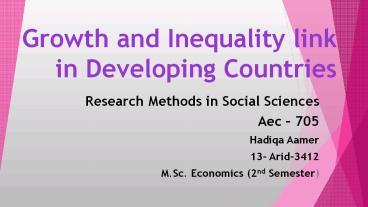Growth and Inequality link in Developing countries. - PowerPoint PPT Presentation
Title:
Growth and Inequality link in Developing countries.
Description:
Main concepts for the beginners. – PowerPoint PPT presentation
Number of Views:21
Title: Growth and Inequality link in Developing countries.
1
Growth and Inequality link in Developing Countries
- Research Methods in Social Sciences
- Aec 705
- Hadiqa Aamer
- 13- Arid-3412
- M.Sc. Economics (2nd Semester)
2
Gini Coefficient and Lorenz Curve
- Gini Coefficient is known as the measure of
Inequality of a distribution after the original
work of Italian Corado Gini in 1912. However
the glimpse of it is seen before in 1905 in the
work economist Max Lorenz. - The Lorenz curve can be used to show what
percentage of a nation's residents possess what
percentage of that nation's wealth. For example,
it might show that the country's poorest 10
possess 2 of the country's wealth..
3
Gini Coefficient Graph.
On the graph, a straight diagonal line represents
perfect equality of wealth distribution the
Lorenz curve lies beneath it, showing the reality
of wealth distribution. The difference between
the straight line and the curved line is the
amount of inequality of wealth distribution The
Gini index measures the area between the Lorenz
curve and a hypothetical line of absolute
equality. Expressed as a percentage of the
maximum area under the line. Thus a Gini index of
0 represents perfect equality, while an index of
100 implies perfect inequality.
4
Kuznets Curve
Kuznets Hypothesis In 1955 Simon Kuznets gives
Hypothesis. According to which, When the per
capita income rises, inequality of income
distribution may also rise initially. Only when
the level of aggregate income has reached a
certain level, the trend reverses. Thus the
universally observed phenomenon is that
economic growth can never be equally
distributed e.g. New Technology.
5
- How income inequality effects growth of
developing countries? - For answering this question I will take 50
countries cross sectional data of 2008 of two
variables that are GDP per capita annual growth - and Gini Index and I will going to apply ordinary
least square (OLS) Regression techniques to get
our result for that Im going to use two models
that are - Simple linear regression in which GDP per capita
growth rate is dependent variable and Gini index
as independent variable. - GDP Per capita growth Bo B1 Gini Index Ui
- Lin-Log model in which GDP per capita growth rate
is dependent variable and Log of Gini Index is
independent variable. - GDP Per capita growth Bo B1 Log (Gini Index)
Ui
6
Model 1
Variables Coefficients t-stat p-value R-square
C 11.13797 3.023204 0.004 0.062057
Gini -0.159291 -1.782079 0.0811
Hetroskedasticity Autocorrelation
ObsR-squared 0.05306 ObsR-squared 0.897011
Prob. Chi Square(1) 0.8178 Prob. Chi-Square(2) 0.6386
- GDP per capita growth 11.1380 0.1593 Gini
Index. - Showing negetive relationship between GDP per
capita growth and Gini Index. - When Gini Index is increase by one unit the
average GDP per capita growth decreases by 0.1593
percent and vice versa. - P-value of both t-stat and f-stat is 0.0811 which
means at 10 level of significance the model is
statistically as well as overall significant. - P-value of Observed R square is greater than 0.05
showing data is free from Heteroskedasticity and
Autocorrelation.
7
Model 1 Graphs
8
Model 2
Variables Coefficients t-stat p-value R-square
C 29.46799 2.205986 0.0322 0.066936
Log GINI -15.51483 -1.85564 0.0697
Hetroskedasticity Autocorrelation
ObsR-squared 0.054097 ObsR-squared 0.992346
Prob. Chi Square(1) 0.8161 Prob. Chi-Square(2) 0.6089
- GDP per capita growth 29.46799 (15.51483) Log
Gini Index. - Negative relationship between GDP per capita
growth and Log of inequality which is showing
model is economically significant. - When gini index is increase by one percent then
average GDP per capita will decrease by 15.51483
percent. - P-value of t-stat and f-stat is 0.0697 which is
showing at 10 level of significance model is
statistically as well as overall significant. - P-value of Observed R square are 0.8161 and
0.6089. As both values are greater than 0.05
which means accept null hypothesis of No
Hetroskedasticity and No Autocorrelation.
9
Model 2 Graphs
10
Comparison of Both Models
- Model 1
- Model 2
- Theoretically significant. Statistically and
Overall consistent. But at 10 level of
significance. - Coefficient of determination (R-square) is
0.062057. - Less consistent by graphical representation.
- Model is free from Hetroskedasticity and Serial
Correlation.
- Theoretically significant. Statistically and
Overall consistent. But at 10 level of
significance. - Coefficient of determination (R-square) is
0.066936 - Graphs show that model is more consistent.
- Model is free from Hetroskedasticity and
Autocorrelation.
11
Conclusions
If our motive is to just predict then we can use
these simple model as it is economically
significant. But if we want reliable estimates
then we will fail to find at 5 level of
significance while at 10 we can find reliable
estimates as well. So as compare to different
hectic model this model is very easy and will
conclude nearly same results like those hectic
models. However it is cross-sectional data but
still it is not infected by Heteroskedasticity
and Serial Correlation which showing models are
good. (Kuznet, Simon. 1955), (Robert J. Barro,
2000), (Robert J. Barro, 2008), (Klaus Deininger
and Lyn Squire, 1996), (Ms. Kit Ying Sharon Chan,
2006) All of these researchers use panel data or
time series data while Barro use cross
sectional data in 1991 but the model they used
are so complex. While I have use very simple
model by using only one explanatory variable that
is Gini index.

